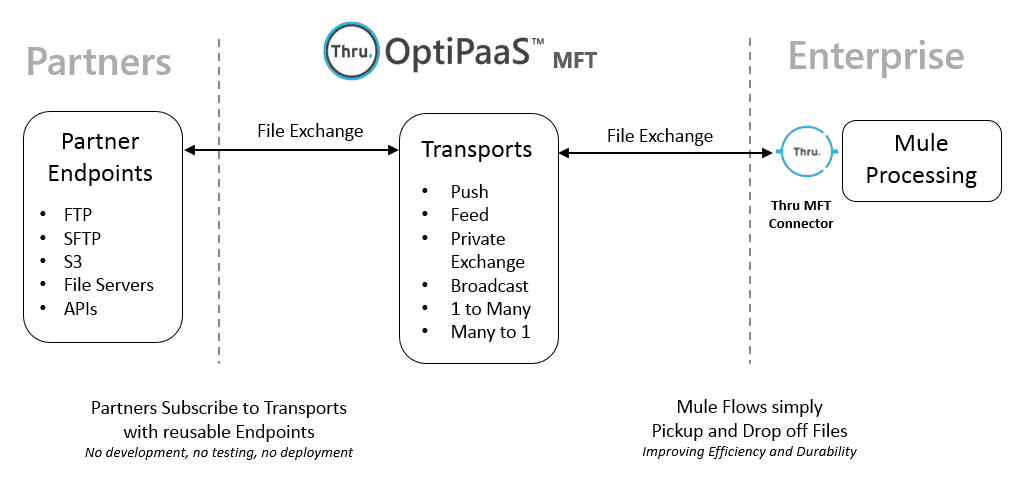The orchestration of system-to-system file transfers by enterprises with external trading partners (commonly known as B2B file transfer) has been around for decades; as far back as the beginning of standard network protocols.
As company leaders now make a push for “platform-centric” business and IT models, many IT departments are trying to find a way to centralize all their B2B file exchange processes to improve visibility and control.
New technologies introduced in this present Fourth Industrial Revolution like SaaS, IoT, mobile applications and AI have created new requirements for file exchange systems to seamlessly integrate with these new technologies that span across cloud and on-premises locations. This is proving to be far more complex than many IT leaders have realized.
IT departments need to rethink their company’s B2B file exchange strategy in order to increase the agility and efficiency of processes with their global partner network.
The challenges of integrating B2B file exchange systems
Back in the 80s and 90s companies started integrating file transfer processes with partner systems via point-to-point connections by creating and managing custom scripts between systems via protocols like FTP/SFTP/AS2 among others.
Managed file transfer (MFT) systems were introduced in the early 2000s as a better way to manage these transactions with centralized management of endpoints and a higher level of security. But many of today’s MFT systems today are still relying on point-to-point integrations with other partner systems and have no centralized way to view and control activities in real-time.
A big reason that point-to-point integrations are a problem is that they are non-reusable and require extensive enterprise effort to create and manage. It forces developers to constantly create the same integrations over and over again when new partners come on board. This makes integration efforts more expensive and time-consuming since each integration also requires detailed tasks like managing user credentials, certificates and endpoint configuration.
For example, a large retail company has a “purchase order process” where it needs to automatically pull files from the file servers of 50 different partners for processing in its internal systems. Developers using point-to-point integrations (which are not reusable) to connect to the external systems must build a unique connection for all 50 partners from scratch. If each partner has at least 3 endpoints (e.g. SFTP, Amazon S3, email server) then that is 150 integrations for just 1 business process! This is a substantial reason for why B2B file exchange integration has become a tangled mess and is difficult to unravel and simplify.
To add to the problem, many MFT systems do not have a centralized way to view all of the file exchange integration activities going on across internal and partner systems. It causes companies to be in the dark for certain actions like when file transfers fail; this is a big problem because it means companies can’t accurately verify whether or not critical information was picked up or delivered.
Simplify B2B file exchange with Thru’s MFT Connector for MuleSoft
So how can companies untangle B2B file exchange integration? By far the best approach for today’s complex requirements is to replace point-to-point methods with an “API-first” approach. Creating a series of reusable file exchange APIs can greatly reduce the amount of development required by IT teams and increases the agility of partners to be onboarded quickly and efficiently to core processes.
To provide a way for companies to easily design, build and integrate file transfers into business processes, MuleSoft and Thru partnered to create the Thru MFT Connector for MuleSoft. This is an API-based approached to file exchange integration that adds “reusability” of file exchange endpoints that requires no coding by developers or partners.
With this connector, companies using Thru’s cloud-based MFT platform, OptiPaaS, can instantly connect B2B file exchange workflows to business processes running in their MuleSoft application network. Partners self-subscribe to file exchange processes in OptiPaaS so MuleSoft developers do not need to write any code and do not need any partner endpoint details to add into Mule flows.
How does it work? Admins in OptiPaaS create different types of file exchange workflows called “transports” and make them available to “subscribers” (partners, internal departments). A self-service portal in OptiPaaS enables all partner organizations to subscribe to transports and set up their own endpoints. Using the Thru MFT Connector, Mule developers can then add OptiPaaS transports into Mule flows by simply dragging and dropping the Thru MFT microservices into Mule flows. Mule developers do not need to write any code and do not need any partner endpoint details. OptiPaaS handles all file pickup, drop off and exception handling with no limit on file size or file type.

As companies pursue the modernization of business applications and infrastructure at an unprecedented rate, it’s important for IT departments to rethink how B2B file exchange is integrated across all other business processes. Using reusable APIs like with the Thru MFT Connector instead of point-to-point integrations can greatly simplify and add agility to these critical processes.
Download the Thru MFT Connector for MuleSoft Datasheet to learn how to easily design, build and integrate B2B file transfers into your MuleSoft business processes.









